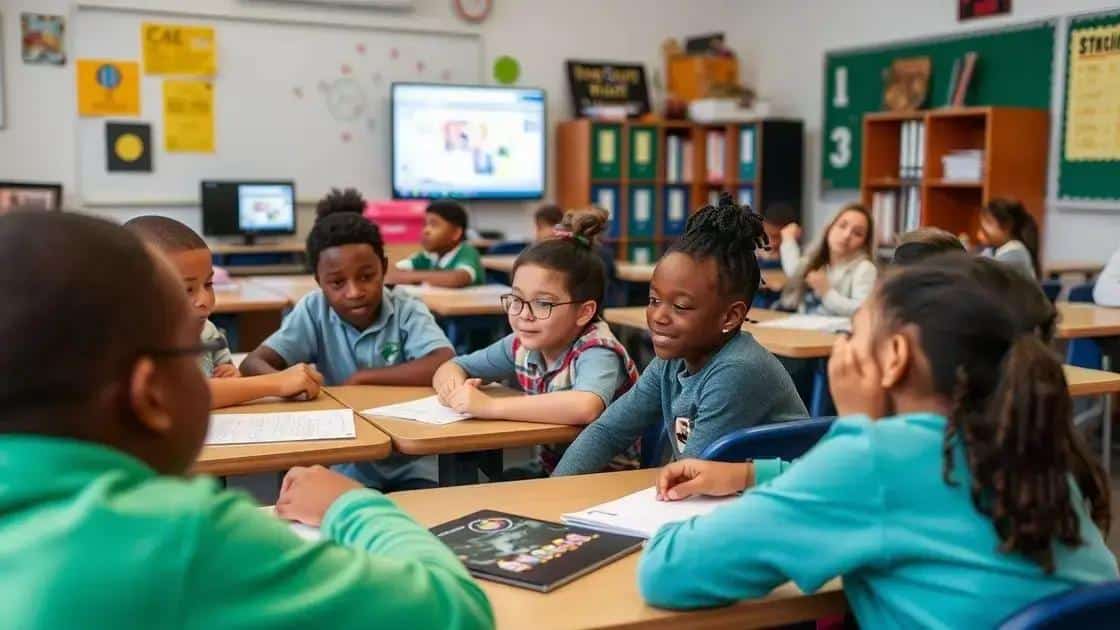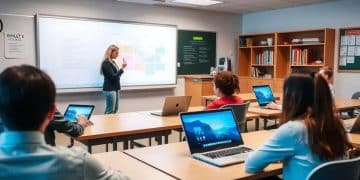Media learning disability support: unlocking potential

Media learning disability support involves tailored strategies and resources that enable students with learning disabilities to effectively engage with educational content, ensuring their success in academic environments.
Media learning disability support plays a crucial role in helping learners with diverse needs thrive. Have you ever wondered how different media can transform education and ensure everyone has a fair chance at success? Let’s dive deeper into this essential topic.
Understanding media learning disabilities
Understanding media learning disabilities is fundamental for creating inclusive educational environments. These disabilities can affect how students process information, particularly when it comes to media and technology. It’s essential to recognize these challenges and explore ways to support learners effectively.
One common type of media learning disability is the difficulty with visual or auditory processing. This means that some learners may struggle to interpret what they see or hear in educational materials. By understanding these disabilities, educators can adapt their teaching methods.
Types of Media Learning Disabilities
There are several types of media learning disabilities that educators and caregivers should be aware of. Each disorder presents unique challenges that require specific strategies.
- Dyslexia: Difficulties in reading and interpreting words.
- Dyscalculia: Challenges with numbers and math-related tasks.
- Dysgraphia: Difficulty with writing and spelling.
- Auditory Processing Disorder: Challenges in processing spoken information.
By identifying these disabilities early, educators can implement tailored instruction that accommodates each student’s needs. Support strategies may include the use of specialized software or engaging multimedia that enhances understanding.
Furthermore, creating a supportive atmosphere is crucial. Educators should foster open communication and encourage students to share their difficulties. This creates a collaborative environment that can motivate students to learn. When students feel understood, they are more likely to participate actively.
Incorporating diverse media types—inclusive videos, audio resources, and interactive elements—can also improve comprehension. For example, using visual aids alongside text can enhance learning for those with dyslexia. It’s all about finding the right balance between engagement and accessibility.
Importance of support in educational settings
The importance of support in educational settings cannot be overstated. Every student deserves the chance to succeed, especially those with learning disabilities. Support systems help create an inclusive environment where all learners can thrive.
Providing adequate support is essential for fostering confidence and motivation among students with learning disabilities. When teachers and staff actively engage with these students, it leads to a more effective learning experience.
Benefits of Educational Support
There are numerous benefits to implementing strong support systems in schools. Recognizing these advantages can help motivate educators to prioritize accessibility.
- Improved academic performance: Students who receive tailored support often achieve better grades.
- Enhanced self-esteem: Support empowers students to believe in their abilities.
- Increased participation: When students feel understood, they are more likely to engage in class.
- Better social skills: Supportive environments foster positive interactions among peers.
Support can take various forms, such as tutoring, mentorship programs, or the use of specialized technologies. Each approach addresses the unique needs of students, ensuring they have the tools necessary to succeed.
Every teacher plays a crucial role in this process. By actively recognizing the different ways students learn, they can modify their teaching strategies. This adaptability is key in helping students with learning disabilities reach their potential. Collaboration among educators, parents, and specialists further enhances the learning experience.
Technology also plays a vital role in providing support. Utilizing assistive tools can help students better understand the material and complete tasks effectively. For instance, multimedia resources can simplify complex concepts, making education more accessible.
Techniques for effective media learning disability support

Implementing techniques for effective media learning disability support is essential to help students overcome challenges in their learning processes. By using various methods and tools, educators can tailor their approaches to meet individual needs.
One effective strategy involves using assistive technologies. These tools can support students who struggle with reading or writing. With applications and software designed specifically for learning disabilities, students can access materials in more engaging ways.
Types of Techniques to Use
When considering techniques, it’s important to understand the diverse needs of learners. Here are some valuable methods:
- Multi-sensory learning: Involves using visual, auditory, and kinesthetic activities to cater to different learning styles.
- Immediate feedback: Offering prompt responses to students’ work helps reinforce learning and addresses mistakes quickly.
- Visual aids: Incorporating charts, graphs, and images can strengthen understanding and retention of complex information.
- Structured routines: Establishing consistent schedules can help students with learning disabilities feel more secure and focused.
Another approach is breaking down tasks into smaller, manageable steps. This technique can alleviate feelings of being overwhelmed and allows students to achieve success incrementally. By focusing on one step at a time, students can build their confidence and skills progressively.
Collaboration among teachers, parents, and specialists is also vital. This partnership fosters a comprehensive support system, ensuring that each child’s learning needs are addressed. Regular communication between all parties helps identify which techniques are working and which need adjustment.
Finally, creating a positive and inclusive classroom culture greatly impacts student success. Encouraging peer support and facilitating group work can enhance social skills alongside academic learning. As students learn to work together and support each other, the overall learning environment becomes more rich and rewarding.
Resources for educators and parents
Accessing the right resources for educators and parents is essential for creating a supportive learning environment for children with learning disabilities. Whether you are a teacher seeking tools for the classroom or a parent looking for ways to assist at home, having the right information can make a significant difference.
Numerous organizations provide valuable resources that focus on training, advice, and materials tailored for individuals with learning disabilities. These resources can help educators and parents understand how to best support students.
Types of Resources Available
Here are some key resources that can be incredibly beneficial:
- Online courses: Many organizations offer free or low-cost courses that focus on strategies to assist students with learning disabilities.
- Webinars and workshops: Regular webinars can provide insights into the latest teaching techniques and support strategies.
- Books and articles: Reading up-to-date literature about learning disabilities can equip educators with fresh ideas and approaches.
- Support groups: Connecting with other parents and educators can provide emotional support and shared experiences.
In addition to these resources, technology can be a great ally. Many educational apps are designed to assist students in developing skills in reading, writing, and mathematics. Parents can encourage the use of these apps at home to reinforce what is learned in school and to promote engagement.
Moreover, local school districts often have programs in place to assist both teachers and parents. Reaching out to special education coordinators can provide insights into specific supports available in your area. These connections can further enhance the resources you have at your disposal.
Finally, advocacy organizations can be a powerful ally. They work to ensure that students with learning disabilities receive the services they need. Getting involved with these groups can keep you informed and help you advocate effectively for your child or students.
Success stories in media learning support
Exploring success stories in media learning support can provide inspiring examples of how innovative strategies and dedicated efforts transform the educational experience for students with learning disabilities. These stories highlight the power of tailored approaches and the positive impact on learners’ lives.
Many schools have implemented unique programs that showcase the effectiveness of media learning support. One such story features a high school that introduced interactive learning tools in their curriculum. Students who had previously struggled with traditional teaching methods began to thrive using these interactive resources.
Examples of Successful Media Learning Initiatives
Here are some notable initiatives that demonstrate significant positive outcomes:
- The Multimedia Project: This initiative combined video lessons with hands-on activities. Students with learning disabilities showed marked improvement in engagement and understanding.
- Assistive Technology Integration: A school equipped classrooms with tablets and specialized software that catered to individual learning styles. Students became more independent and confident in their abilities.
- Peer Mentorship Programs: Pairing students with learning disabilities with peer mentors created supportive relationships. The mentors helped guide their peers through challenges using media resources.
- Family Engagement in Learning: Workshops that involve parents and families taught them how to use media tools at home, significantly improving students’ skills outside the classroom.
These stories emphasize the importance of community and collaboration in fostering success. Teachers, parents, and students working together can create an environment where everyone thrives. Each success story serves as a motivation for others to try similar methods and adapt them to their settings.
Moreover, seeing tangible results inspires educators to continually seek innovative solutions. The victories achieved by these students demonstrate how the right support can unlock their potential, helping them reach their goals.
FAQ – Frequently Asked Questions about Media Learning Disability Support
What is media learning disability support?
Media learning disability support refers to strategies and resources that help students with learning disabilities access and engage with educational content more effectively.
Why is support important for students with learning disabilities?
Support helps create an inclusive environment, boosts confidence, and improves academic performance, ensuring that all students have equal opportunities to succeed.
What types of resources can educators use to support students?
Resources can include assistive technology, online courses, visual aids, and specialized teaching materials tailored to meet individual learning needs.
How can parents help their children with learning disabilities?
Parents can reinforce learning at home using educational apps, maintaining open communication with teachers, and advocating for their child’s needs within the educational system.






